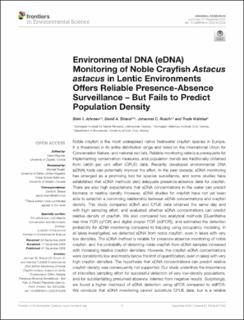| dc.contributor.author | Johnsen, Stein Ivar | |
| dc.contributor.author | Strand, David | |
| dc.contributor.author | Rusch, Johannes | |
| dc.contributor.author | Vrålstad, Trude | |
| dc.coverage.spatial | Europe | en_US |
| dc.date.accessioned | 2021-02-17T10:06:26Z | |
| dc.date.available | 2021-02-17T10:06:26Z | |
| dc.date.created | 2020-12-07T09:36:41Z | |
| dc.date.issued | 2020 | |
| dc.identifier.issn | 2296-665X | |
| dc.identifier.uri | https://hdl.handle.net/11250/2728612 | |
| dc.description.abstract | Noble crayfish is the most widespread native freshwater crayfish species in Europe. It is threatened in its entire distribution range and listed on the International Union for Concervation Nature- and national red lists. Reliable monitoring data is a prerequisite for implementing conservation measures, and population trends are traditionally obtained from catch per unit effort (CPUE) data. Recently developed environmental DNA (eDNA) tools can potentially improve the effort. In the past decade, eDNA monitoring has emerged as a promising tool for species surveillance, and some studies have established that eDNA methods yield adequate presence-absence data for crayfish. There are also high expectations that eDNA concentrations in the water can predict biomass or relative density. However, eDNA studies for crayfish have not yet been able to establish a convincing relationship between eDNA concentrations and crayfish density. This study compared eDNA and CPUE data obtained the same day and with high sampling effort, and evaluated whether eDNA concentrations can predict relative density of crayfish. We also compared two analytical methods [Quantitative real-time PCR (qPCR) and digital droplet PCR (ddPCR)], and estimated the detection probability for eDNA monitoring compared to trapping using occupancy modeling. In all lakes investigated, we detected eDNA from noble crayfish, even in lakes with very low densities. The eDNA method is reliable for presence-absence monitoring of noble crayfish, and the probability of detecting noble crayfish from eDNA samples increased with increasing relative crayfish densities. However, the crayfish eDNA concentrations were consistently low and mostly below the limit of quantification, even in lakes with very high crayfish densities. The hypothesis that eDNA concentrations can predict relative crayfish density was consequently not supported. Our study underlines the importance of intensified sampling effort for successful detection of very low-density populations, and for substantiating presumed absence, inferred from negative results. Surprisingly, we found a higher likelihood of eDNA detection using qPCR compared to ddPCR. We conclude that eDNA monitoring cannot substitute CPUE data, but is a reliable supplement for rapid presence-absence overviews. Combined with eDNA analyses of alien crayfish species and diseases such as crayfish plague, this is a cost-efficient supplement offering a more holistic monitoring approach for aquatic environments and native crayfish conservation. | en_US |
| dc.language.iso | eng | en_US |
| dc.rights | Navngivelse 4.0 Internasjonal | * |
| dc.rights.uri | http://creativecommons.org/licenses/by/4.0/deed.no | * |
| dc.title | Environmental DNA (eDNA) Monitoring of Noble Crayfish Astacus astacus in Lentic Environments Offers Reliable Presence-Absence Surveillance – But Fails to Predict Population Density | en_US |
| dc.type | Peer reviewed | en_US |
| dc.type | Journal article | en_US |
| dc.description.version | publishedVersion | en_US |
| dc.rights.holder | © 2020 Johnsen, Strand, Rusch and Vrålstad. | en_US |
| dc.source.journal | Frontiers in Environmental Science | en_US |
| dc.identifier.doi | 10.3389/fenvs.2020.612253 | |
| dc.identifier.cristin | 1856734 | |
| dc.relation.project | Norges forskningsråd: 243907 | en_US |
| cristin.ispublished | true | |
| cristin.fulltext | original | |
| cristin.qualitycode | 1 | |

